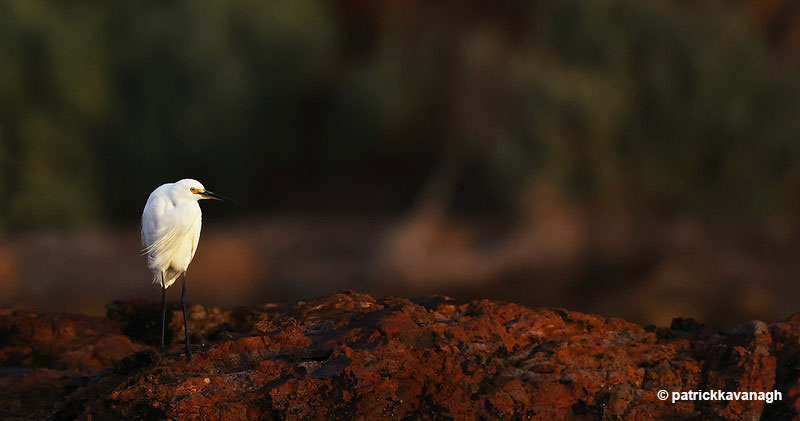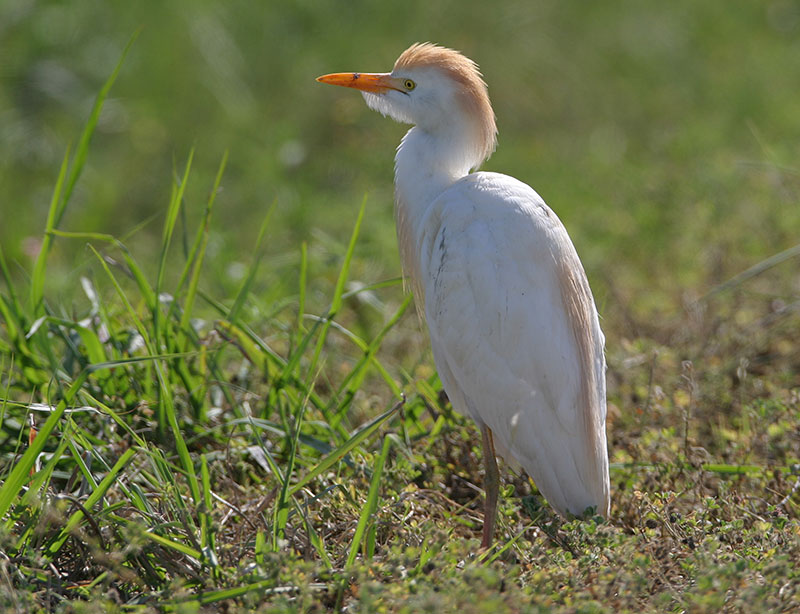
The United States is home to several species of egrets, which are wading birds found in wetland habitats. In this writing, we will discover one of the most common egret species found in the United States:
All of these egret species are protected under the Migratory Bird Treaty Act and are important indicators of the health of wetland ecosystems in the US.
It this guide, we will show you Cattle Egret, Great Egret, Reddish Egret, Snowy Egret, and Little Egret.
Cattle Egret
Bubulcus ibis
Cattle Egrets are smallish, somewhat stocky herons with thicker and shorter necks than other egret species. These 20 inch long birds also have shorter beaks than other egrets, and long, broad wings that span three feet.
In spring and summer, Cattle Egrets are white with buff patches on their head, chest, and back. At this time of year, their beaks are orange and their legs are reddish.
From August to February, they lack buff patches, have yellow beaks, and black legs. Both sexes are similar but juveniles in late summer and fall are white with black beaks and dark legs.
Cattle Egrets breed in colonies in swamps and other wetland habitats. They are very common in coastal habitats in the eastern USA and in the southeastern USA. However, they also occur in many parts of the central and western USA and other parts of the world.
True to their name, this heron species is very much tied to cattle and other large mammals!
The birds follow cows and other big mammals to catch insects, frogs, and other small creatures flushed into the open. This behavior is so ingrained, in the absence of large mammals, the egrets probably couldn’t survive for long.
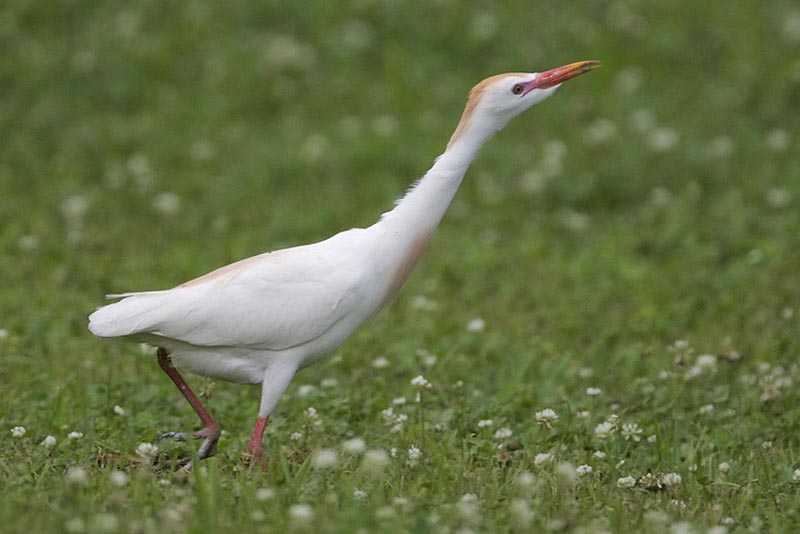
At the peak of the breeding season bill can become red-orange and legs red. The peak of breeding plumage is sometimes referred to as the “high breeding plumage.” Photo © Sam Crowe
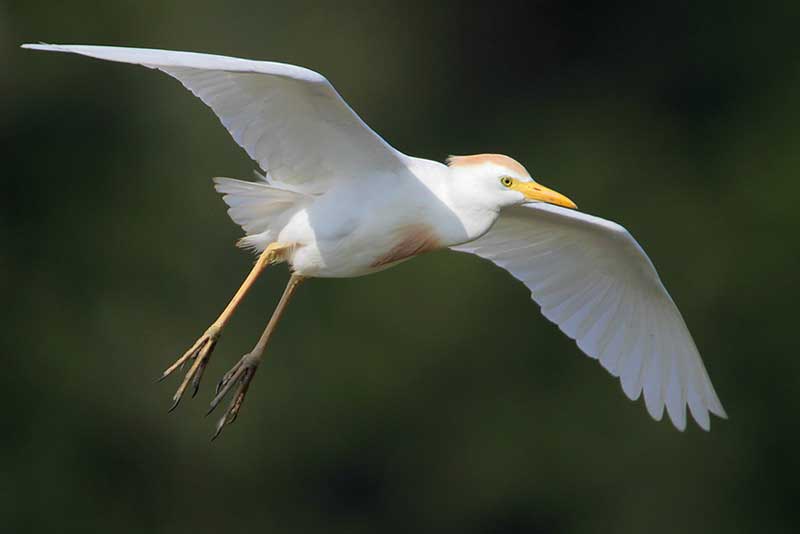
Adult in spring plumage. Not the color of the legs. Muddy legs or movement into and out of high-breeding plumage can cause confusion on leg color. Photo © Greg Lavaty
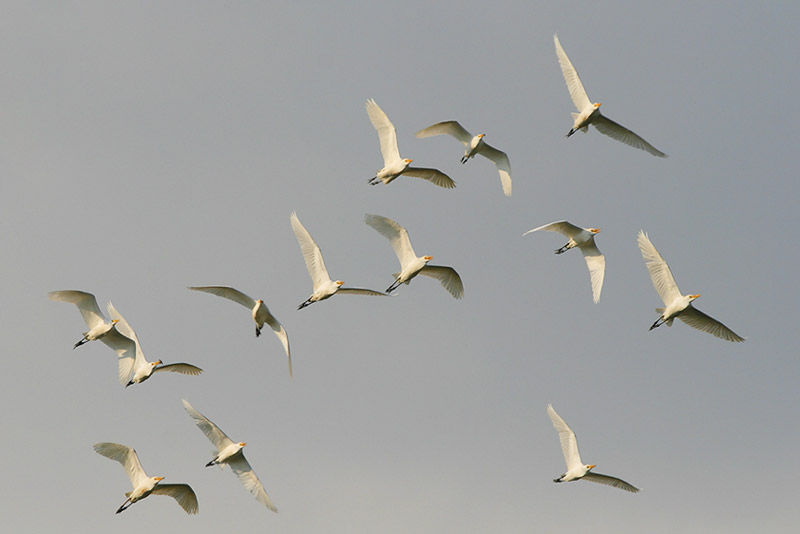
Cattle Egrets are often seen flying in small flocks. Photograph © Greg Lavaty.
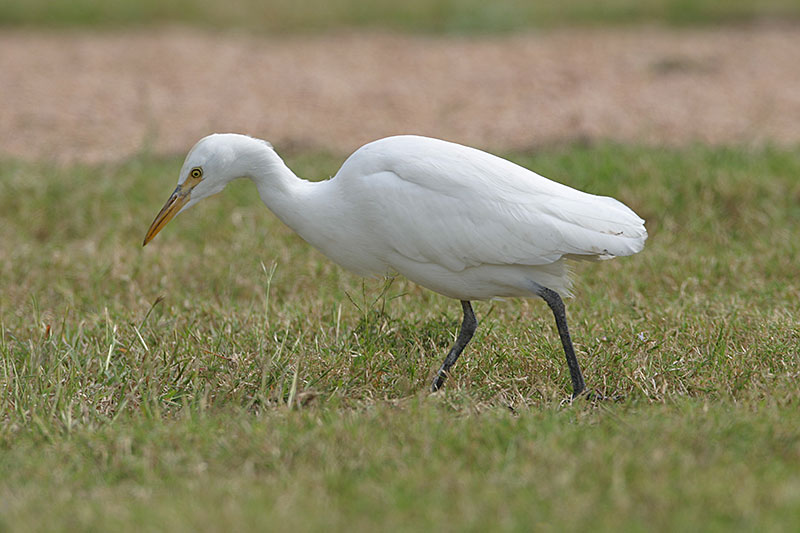
Juvenile Cattle Egrets have a black bill which gradually turns yellow in late summer. Photograph ® Sam Crowe
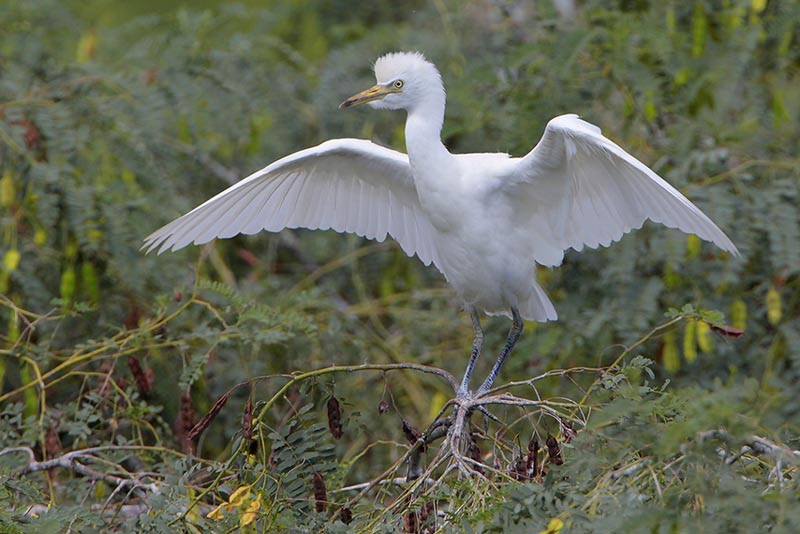
Juvenile Cattle Egret with dark legs. Legs are yellowish in adults. Photograph ® Greg Lavaty
Great Egret
Ardea alba
Great Egrets are tall white birds with very long necks and a long, sharp, yellowish beak. These 39 inch long herons also have long black legs and feet, and their wingspan measures more than four feet. They fly with steady, slow flaps, and with their neck tucked in.
Both sexes look the same all year long. However, during the breeding season, long, wispy plumes on their back extend over the bird’s short, broad tail.
Great Egrets make bulky stick nests in trees in swamps and other wetlands. Although they nest in colonies, these herons usually forage on their own. The Great Egret typically stands very still in marshes, or at the edges of rivers and other wetlands.
When the egret spots a small fish, frog, crustacean, or other unlucky animal, the bird quickly stabs out with its beak to snatch its prey. This bird isn’t fussy about what it eats and can prey on everything from fish to small snakes and even small birds!
We see Great Egrets in all sorts of wetland habitats. They are common on the east coast of the USA and in California and southern states. Smaller numbers also occur in southeastern Canada and most other parts of the USA.
Interestingly, Great Egrets are actually herons, so even though they are called egrets, they are not actually true egrets.
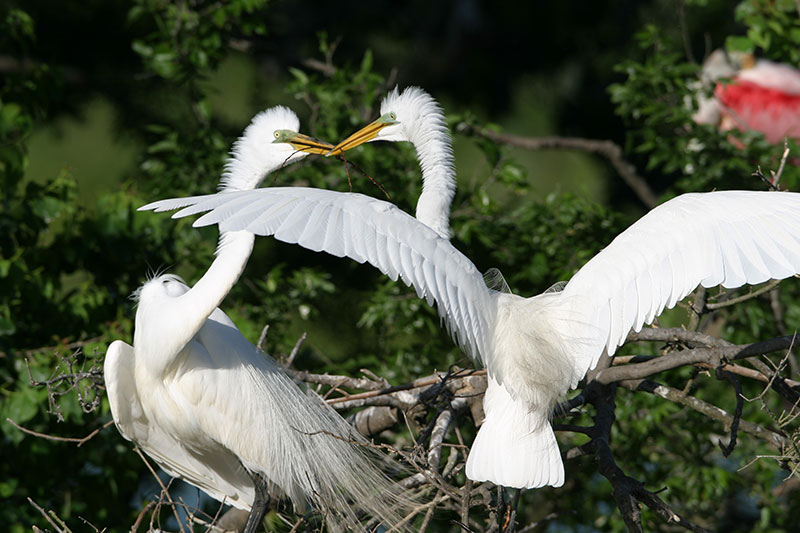
Adults exhibiting courtship behavior. Photograph © Sam Crowe.
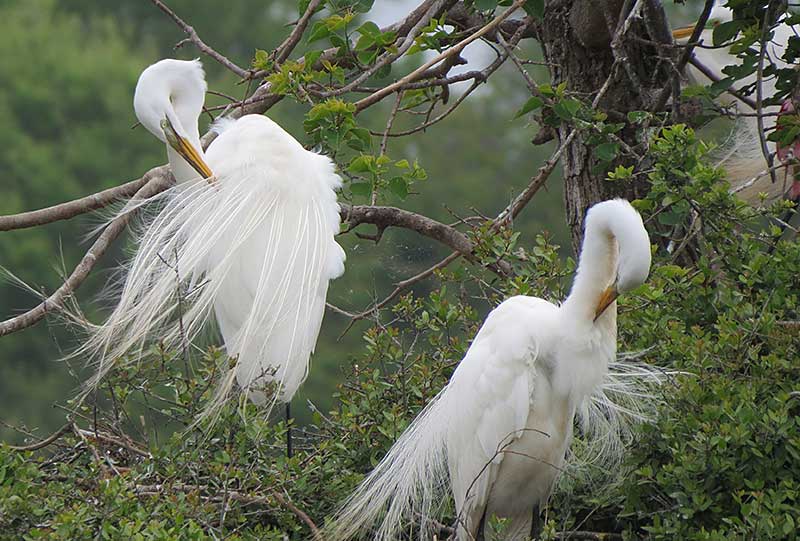
Long, flowing plumes are present during the breeding season, absent most of the year. Photograph © Sam Crowe.
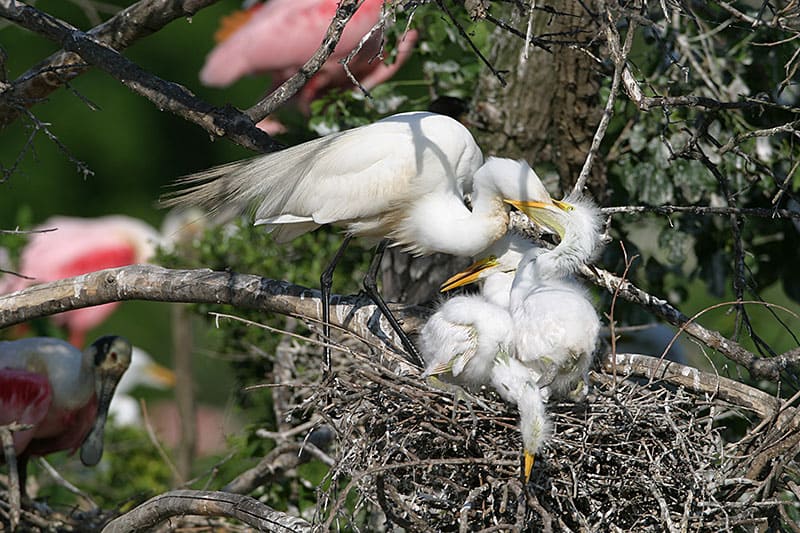
Great Egret feeding young.
Infant aggression is common among Great Egrets and other egret species. To obtain the most food, older chicks will often peck and pester a younger, smaller chick to death. The third-born chick in a group of three Great Egret chicks is often killed by its siblings. The parents do not interfere.
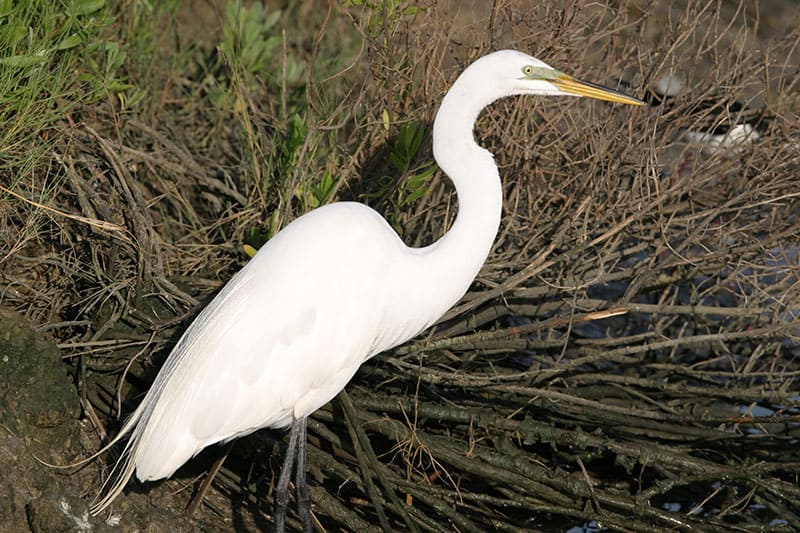
Great Egret’s bill is usually yellow. Photograph © Sam Crowe
The bill is usually yellow. During breeding season the area in front of the eye turns greenish and the bill can have a dark edge on the top.
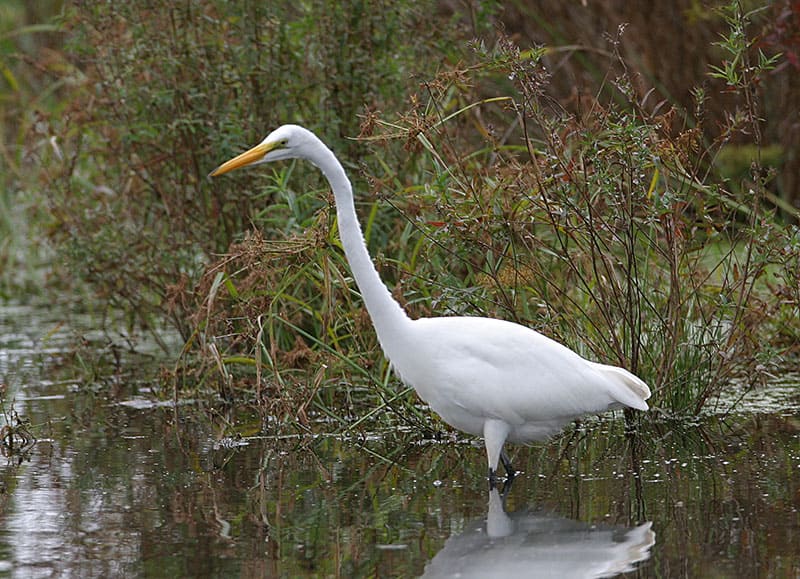
Great Heron. Photograph © Sam Crowe
Great Egret with the typical yellow bill and lack of plumes.
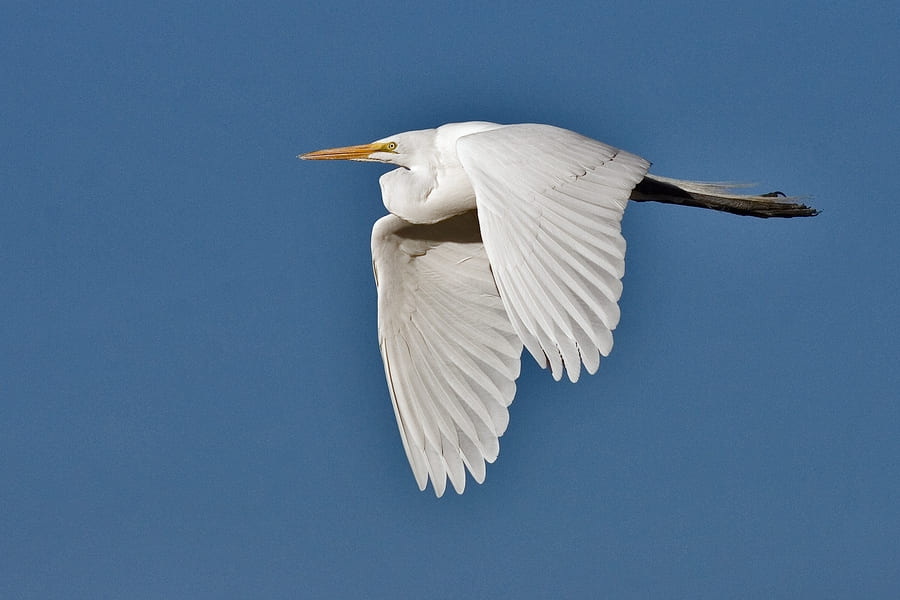
Flyin Great Heron (Look at the shape). Photograph ©Alan Wilson.
Egrets fly with the neck pulled in next to the body. Cranes fly with the neck extended.
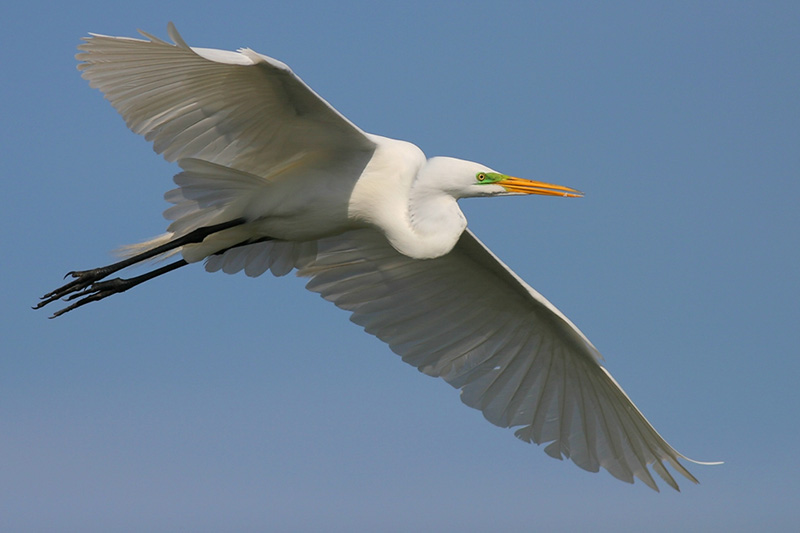
Great Egret showing long black legs. Photograph © Greg Lavaty.
Great Egret showing long black legs. Greenish color in front of the eye present duing breeding season.
Reddish Egret
Egretta rufescens
Reddish Egrets are tall and elegant wading birds with long, dark legs, and a long, sharp beak. Adults of both sexes look the same, have a pink bill with a black tip, a short shaggy crest, and some elongated plumes on their chest and back. However, they can be one of two color morphs.
This species can have white plumage or be slate gray with an orange-brown head and neck. Young birds are all white with a dark beak and dark around their eyes, or have patchy pale gray-brownish plumage.
As with other heron species, Reddish Egrets make bulky stick nests in small colonies. However, they feed on their own. The unique way these birds forage is also one of the best ways to recognize them!
Instead of carefully stalking and waiting for a hapless fish to swim within reach, Reddish Egrets are very active. These fun birds pursue small fish with short dashes and turns, often while holding their wings open!
Unlike most other herons, this species is also local and uncommon. The Reddish Egret only uses warm, shallow coastal waters. In North America, they mostly occur in parts of Florida, Texas, and other areas along the Gulf of Mexico.
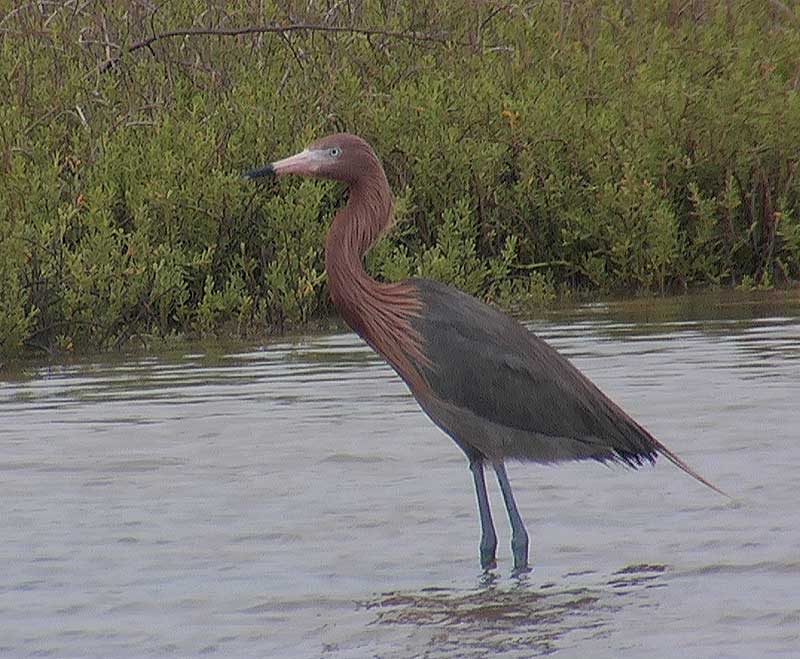
Adult dark-morph Reddish Egret. Note pink bill with black tip. Photograph © Sam Crowe
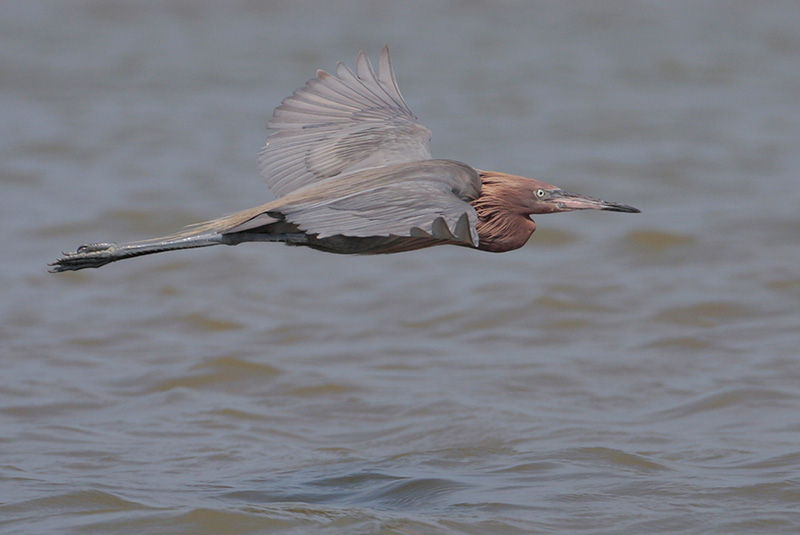
Reddish Egret showing bi-colored bill. Photograph © Greg Lavaty
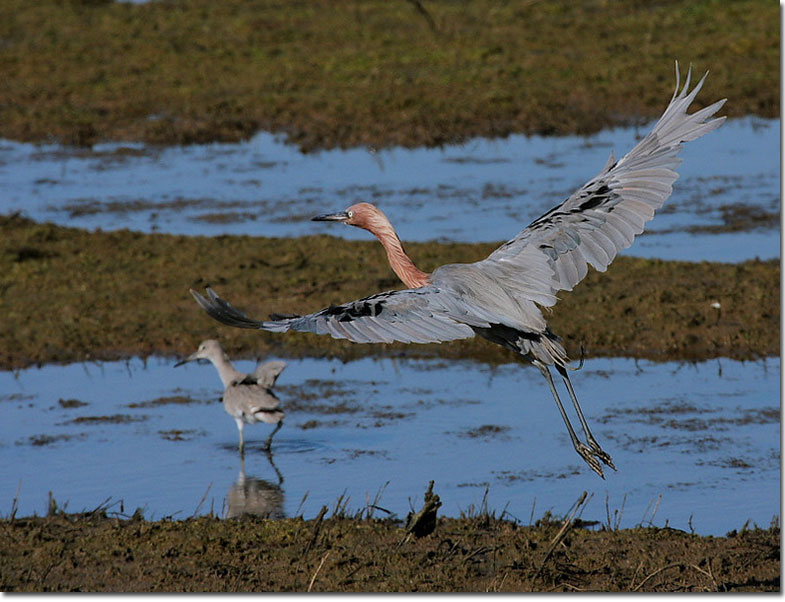
Reddish Egret with Willet in the background.
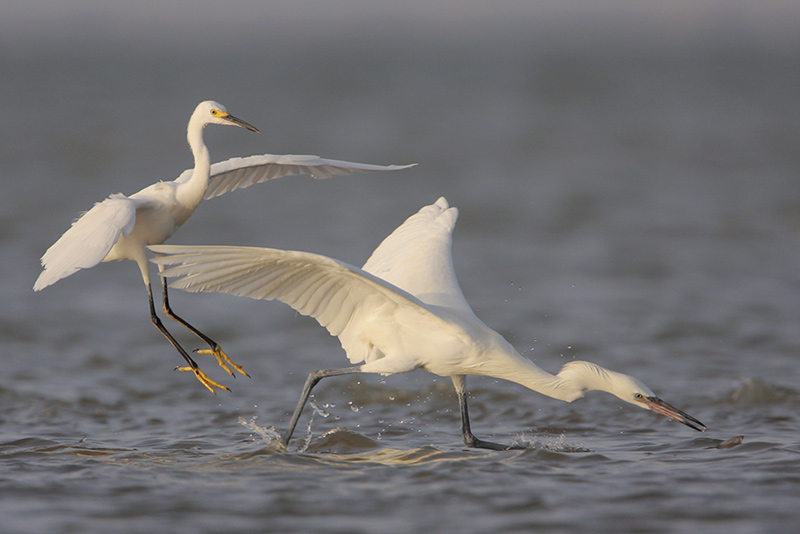
Photograph © Greg Lavaty
This white morph Reddish Egret shows the typical two-tone bill, although the upper bill has not quite turned as pink on the lower 2/3rds of the bill. Perhaps indicating a young bird just before obtaining fill adult characteristics. The trailing bird with the yellow “slippers” is the smaller Snowy Egret.
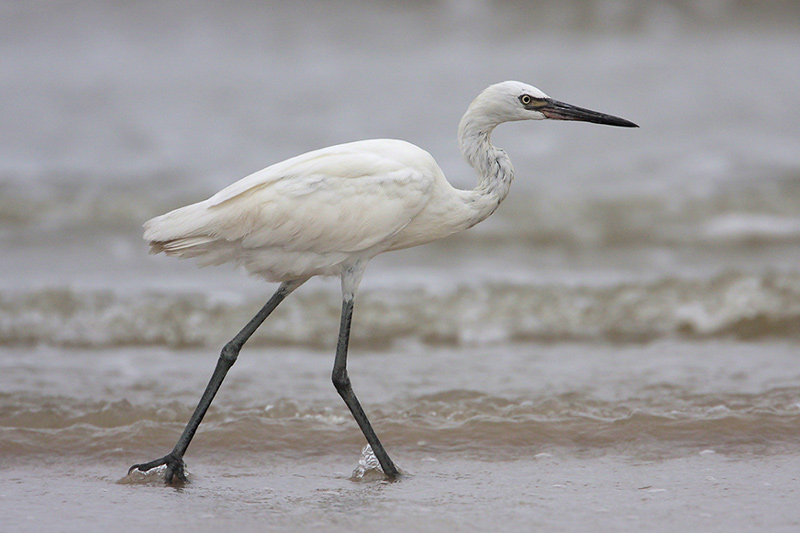
Juvenile Reddish Egrets in light phase has a dark bill (Yes, it is white!). Photograph © Greg Lavaty
Juvenile Reddish Egrets in light phase has a dark bill. Dark phase Reddish Egret is similar to adult but grayer overall. The Great Egret is similar is size but has a yellowish bill.
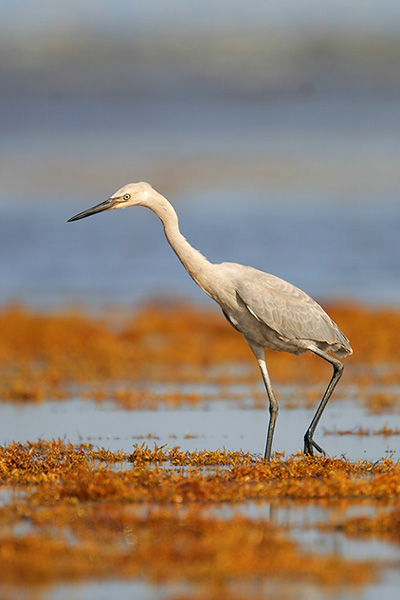
Dark phase juvenile Reddish Egret. © Greg Lavaty
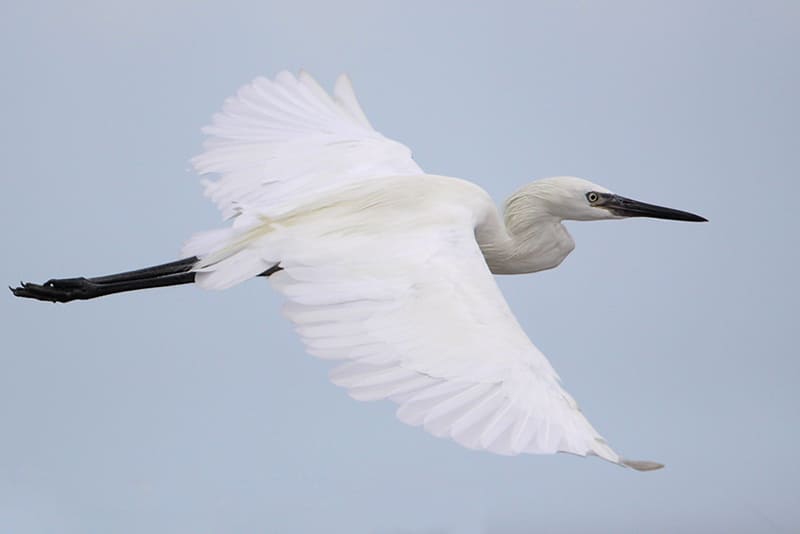
Juvenile white-morph Reddish Egret. Photograph © Greg Lavaty
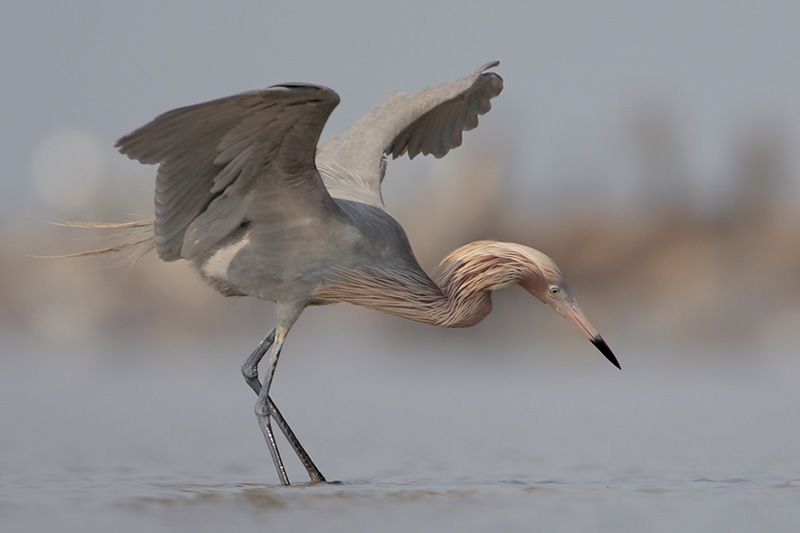
Reddish Egrets will use a shading technique to help see or startle food items. © Greg Lavaty.
Snowy Egret
Egretta thula
Snowy Egrets are medium-sized, slender wading birds with white plumage and a long, straight black beak. They have long black legs with yellow feet (often referred to as “yellow slippers” by birders), a small yellow spot in front of each eye, and long, broad wings.
Like most heron species, Snowy Egrets fly with their neck tucked in and deep slow wing beats. In spring and summer, this species has some shaggy plumes on the back of its head and chest. It also has plumes on its lower back that curl up.
This common egret nests in colonies and feeds in marshes and many other wetlands. While foraging, they can be great subjects for the camera! As they wade on beaches and stalk small bodies of water, Snowy Egrets often let you get fairly close.
Snowy Egrets use their beak to snatch small fish and other small aquatic creatures. They catch them after waiting in or at the edge of the water but can also run after small fish.
This species is easy to see in coastal habitats, marshes, and other wetlands north to Oregon, Minnesota, and Maine. Once in a while, they are also show up in the Rocky Mountains, Canada, and the northern USA.
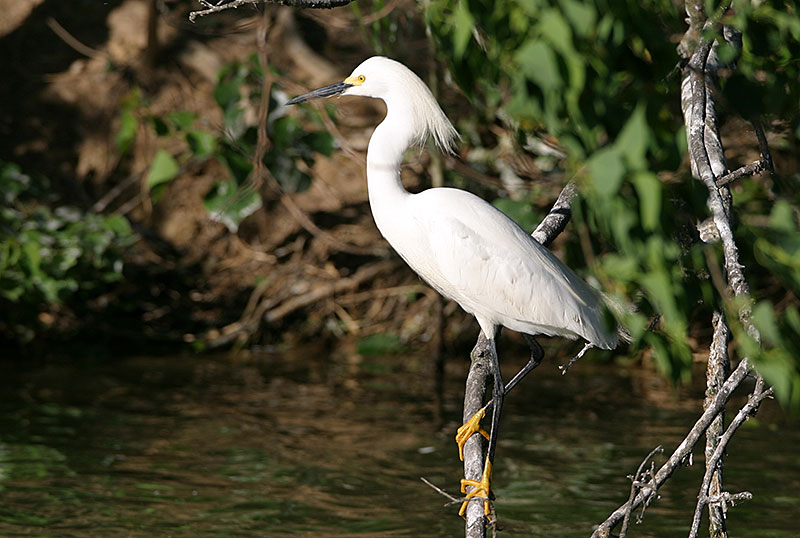
Snowy Egret © Sam Crowe
A typical Snowy Egret with thin, black bill, yellow in front of the eye and yellow feet. Plumes on the head may be reduced or not visible. © Sam Crowe
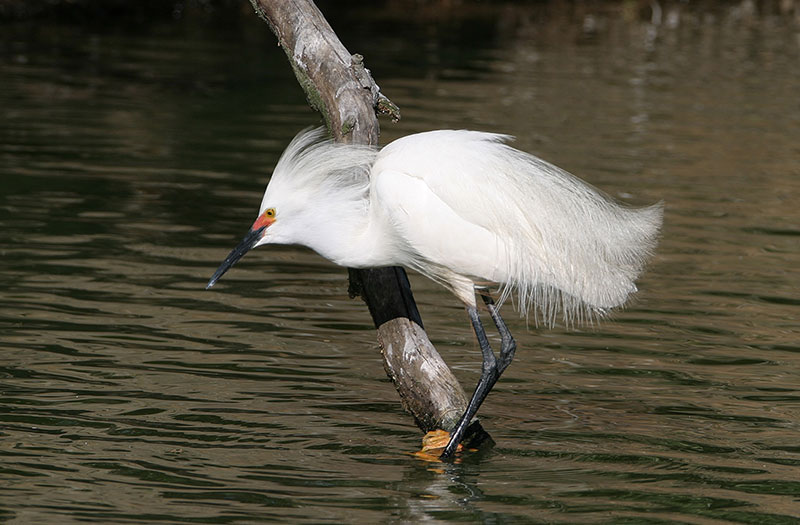
© Sam Crowe
In high breeding plumage the base of the bill becomes red and the feet become orange.
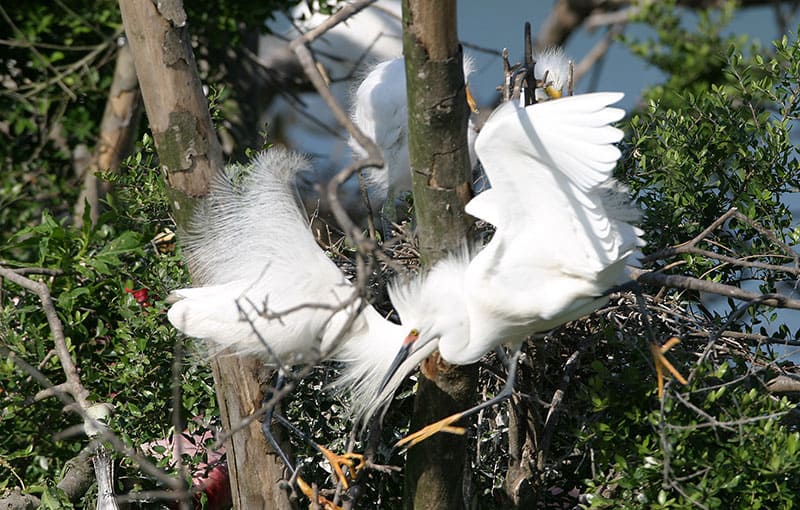
© Sam Crowe
A typical Snowy Egret with thin, black bill, yellow in front of the eye and yellow feet. Plumes on the head may be reudced or not visible.
Snowy Egrets nest in trees, often in mixed colonies with other egret species.

The nest is a substantial collection of sticks that would seem to offer little comfort to babies.
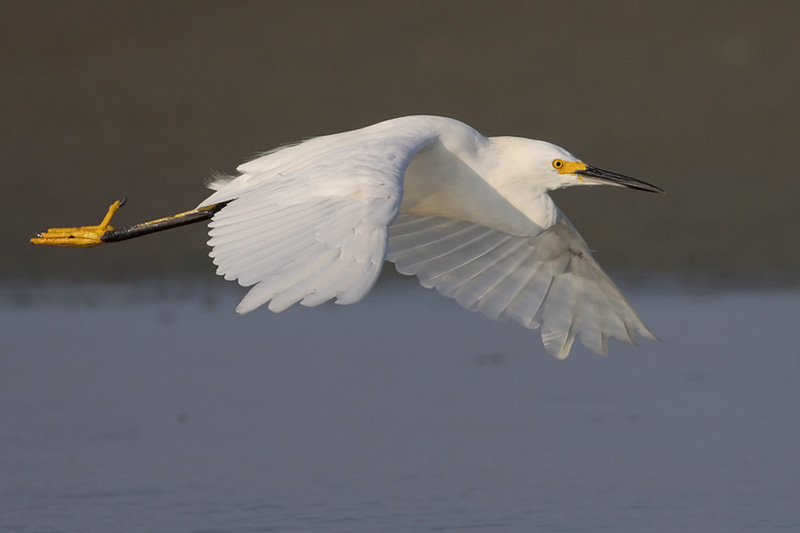
Photograph © Greg Lavaty
The yellow feet are often very obvious when the bird is in flight. Notice the yellow lores, the yellow area in front of the eye.
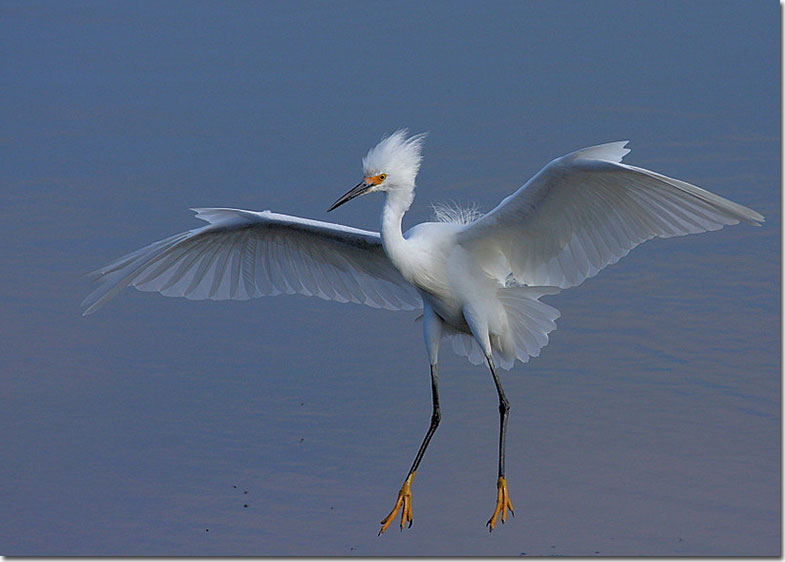
© Steve Wolfe Snowy Egret on approach.
Little Egret
Egretta garzetta
The Little Egret is a slender, medium-sized egret with a long, straight, dark beak. Both sexes look the same, are all white, and have yellow feet on long black legs.
In spring and summer, they also have two long, elegant plumes that extend from the back of their head, plumes on their chest, and straight, wispy plumes on their lower back. For the rest of the year, Little Egrets look similar but only have wispy plumes on their chest and have yellow on the lower parts of their legs.
This beautiful bird is 25 inches long and has a 42 inch wingspan. They use their long and broad wings to fly with steady, deep flaps.
Like other heron species, Little Egrets nest in colonies but usually forage alone. They wait and stalk in and near shallow waters to catch small fish, and other small animals with their sharp beaks.
This species normally lives in Eurasia and Africa but a few birds are occasionally seen on the east coast of North America. It looks almost exactly like the Snowy Egret but has a straighter beak, usually has dark around its eyes, does not have curled plumes on its back, and has two long plumes on its head.


